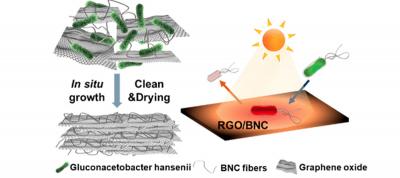Researchers from Washington University have designed a novel membrane technology that purifies water while preventing biofouling, or buildup of bacteria and other harmful microorganisms that reduce the flow of water. And they used graphene and bacteria to build these filtering membranes.

The team developed an ultrafiltration membrane using graphene oxide and bacterial nanocellulose that they found to be highly efficient, long-lasting and environmentally friendly. If their technique were to be scaled up to a large size, it could benefit many developing countries where clean water is scarce.
Their new membrane begins with feeding Gluconacetobacter hansenii bacteria a sugary substance so that they form cellulose nanofibers when in water. The team then incorporated graphene oxide (GO) flakes into the bacterial nanocellulose while it was growing, essentially trapping GO in the membrane to make it stable and durable.
After GO is incorporated, the membrane is treated with base solution to kill Gluconacetobacter. During this process, the oxygen groups of GO are eliminated, making it reduced GO. When the team shone sunlight onto the membrane, the reduced GO flakes immediately generated heat, which is dissipated into the surrounding water and bacteria nanocellulose.
"If you want to purify water with microorganisms in it, the reduced graphene oxide in the membrane can absorb the sunlight, heat the membrane and kill the bacteria," the team said.
The researchers exposed the membrane to E. coli bacteria, then shone light on the membrane's surface. After being irradiated with light for just 3 minutes, the E. coli bacteria died. The team determined that the membrane quickly heated to above the 70 degrees Celsius required to deteriorate the cell walls of E. coli bacteria.
While the bacteria are killed, the researchers had a pristine membrane with a high quality of nanocellulose fibers that was able to filter water twice as fast as commercially available ultrafiltration membranes under a high operating pressure.
When they did the same experiment on a membrane made from bacterial nanocellulose without the reduced GO, the E. coli bacteria stayed alive.
While the scientists acknowledge that implementing this process in conventional reverse osmosis systems is taxing, they propose a spiral-wound module system, similar to a roll of towels. It could be equipped with LEDs or a type of nanogenerator that harnesses mechanical energy from the fluid flow to produce light and heat, which would reduce the overall cost.